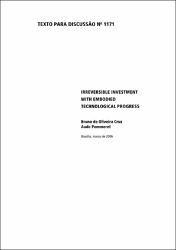Please use this identifier to cite or link to this item:
https://repositorio.ipea.gov.br/handle/11058/2558Full metadata record
| DC Field | Value | Language |
|---|---|---|
| dc.contributor.author | Cruz, Bruno de Oliveira | - |
| dc.contributor.author | Pommeret, Aude | - |
| dc.date.accessioned | 2014-02-24T17:49:50Z | - |
| dc.date.available | 2014-02-24T17:49:50Z | - |
| dc.date.issued | 2006-03 | - |
| dc.identifier.uri | http://repositorio.ipea.gov.br/handle/11058/2558 | - |
| dc.description.abstract | Implicitamente, nas teorias de investimento assume-se que as firmas devam utilizar toda capacidade instalada para investir. Entretanto, tal predição é inconsistente com a observação empírica. O objetivo deste trabalho é o de estender a literatura de investimento irreversível sob incerteza, tornando-a consistente com tal fato, além de duas outras constatações empíricas: o progresso tecnológico incorporado em novas máquinas, a infrequência e a os picos de investimento em nível micro. Além de ser consistente com tais evidências empíricas, a reposição de novas máquinas é adiada pelo aumento da incerteza. Mostra-se ainda que se o progresso tecnológico incorporado e incerteza são consideradas no modelo, a concessão de créditos tributários é ineficaz para estimular o investimento. | pt_BR |
| dc.language.iso | en-US | pt_BR |
| dc.publisher | Instituto de Pesquisa Econômica Aplicada (Ipea) | pt_BR |
| dc.title | Irreversible investment with embodied technological progress | pt_BR |
| dc.title.alternative | Texto para Discussão (TD) 1171: Irreversible investment with embodied technological progress | pt_BR |
| dc.title.alternative | Investimento irreversível no progresso tecnológico incorporado | pt_BR |
| dc.type | Texto para Discussão (TD) | pt_BR |
| dc.rights.holder | Instituto de Pesquisa Econômica Aplicada (Ipea) | pt_BR |
| dc.source.urlsource | www.ipea.gov.br | pt_BR |
| dc.location.country | BR | pt_BR |
| dc.description.physical | p. 44 : il. | pt_BR |
| dc.rights.license | É permitida a reprodução deste texto e dos dados nele contidos, desde que citada a fonte. Reproduções para fins comerciais são proibidas. | pt_BR |
| dc.subject.keyword | Investimento privado | pt_BR |
| dc.subject.keyword | Investimento irreversível sob incerteza | pt_BR |
| dc.subject.keyword | Progresso tecnológico incorporado | pt_BR |
| dc.subject.keyword | Estímulo ao investimento em tecnologia | pt_BR |
| dc.subject.keyword | Tecnologia | pt_BR |
| ipea.description.objective | Mostrar que, apesar das teorias de investimento assumirem que as firmas devam utilizar toda capacidade instalada para investir, a realidade mostra-se de modo diferenciado. | pt_BR |
| ipea.description.additionalinformation | Séries monográficas: Texto para Discussão ; 1171 | pt_BR |
| ipea.description.additionalinformation | Referências bibliográficas: possui referências bibliográficas | pt_BR |
| ipea.description.additionalinformation | Conteúdo: possui apêndice | pt_BR |
| ipea.access.type | Acesso Aberto | pt_BR |
| ipea.rights.type | Licença Comum | pt_BR |
| ipea.englishdescription.abstract | In this paper, we propose to explain capital accumulation in a stochastic framework by taking into account the two main motives for investment. Specifically, firms invest to expand capacity and to replace old machines. The model considers irreversible investment under uncertainty and embodied technological progress. It is shown to be consistent with the following empirical observations: investment is lumpy and infrequent at the firm level; firms can invest even if they have not reached full capacity and technological progress is largely investment specific. We extend the paper of Pindyck (1988), by introducing embodied technological progress. To produce firms use irreversible capital, perfectly flexible labor, and energy whose price is stochastic. Capital and energy are complementary. We show that uncertainty makes firms to postpone investment, increasing the age of the oldest machine and reducing the proportion of new machines in the total stock of capital. We provide an exercise with tax credit to acquire new machines; it is shown that under the hypothesis of embodiment and uncertainty, the tax credit is not effective. | pt_BR |
| ipea.researchfields | N/A | pt_BR |
| ipea.classification | Economia. Desenvolvimento Econômico | pt_BR |
| ipea.classification | Tecnologia. Inovação. Informação. Conhecimento | pt_BR |
| Appears in Collections: | Tecnologia. Inovação. Informação. Conhecimento: Livros | |
Files in This Item:
| File | Description | Size | Format | |
|---|---|---|---|---|
| TD_1171.pdf | 248.75 kB | Adobe PDF |  View/Open |
Items in DSpace are protected by copyright, with all rights reserved, unless otherwise indicated.

